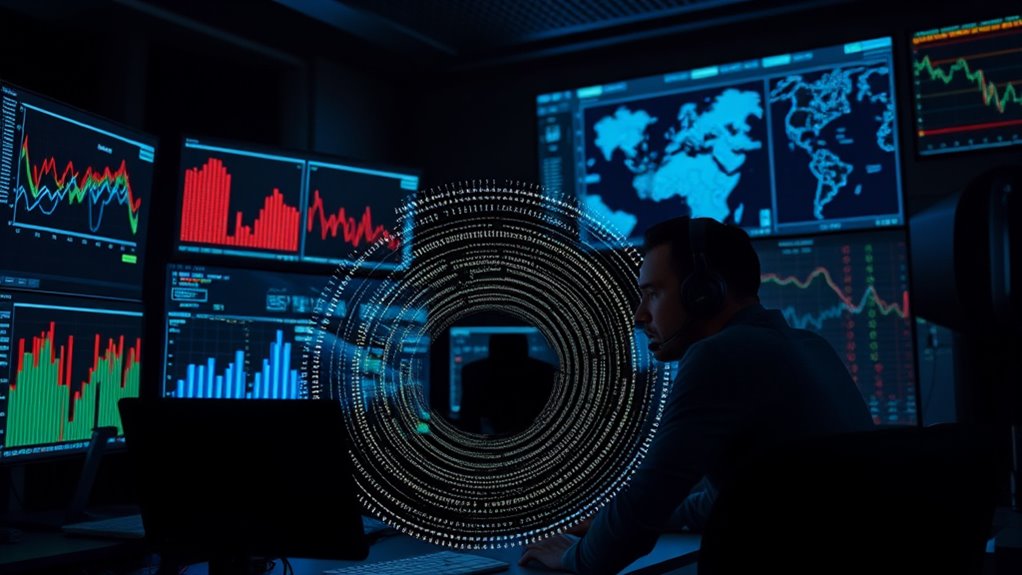AI-driven forensics plays a crucial role in catching spies through digital footprints. It quickly processes massive amounts of data to uncover suspicious behavior and hidden connections. Techniques like forensic copies, cross-drive analysis, and real-time monitoring reveal vital evidence. AI's predictive abilities help anticipate spy activities by analyzing patterns in user behavior and network traffic. As you explore further, you'll discover how AI continues to evolve in the fight against espionage and the challenges it faces.
Key Takeaways
- AI processes vast amounts of digital data to quickly identify suspicious behavior and potential espionage activities.
- Advanced pattern recognition and machine learning algorithms uncover hidden relationships and anomalies in user behavior.
- Real-time analysis and monitoring facilitate immediate identification of threats, enhancing proactive investigations.
- Predictive analysis leverages historical data to anticipate spy activities and improve breach prevention strategies.
- Ethical concerns and data overload challenge the effectiveness of AI-driven forensics in counterintelligence efforts.
The Role of AI in Identifying Digital Footprints

How can AI transform the way we identify digital footprints? AI enhances your ability to analyze digital data by processing vast amounts of information quickly and efficiently.
With advanced pattern recognition, it uncovers suspicious behavior and hidden relationships that might otherwise go unnoticed. You'll benefit from real-time analysis, allowing for immediate identification of potential threats. Moreover, AI generates enhanced data visualizations, making complex data sets easier to understand. It can also predict threats based on historical data, supporting proactive investigations. Additionally, AI can leverage digital footprint analysis to improve the accuracy of identifying fraudulent activities and potential risks.
Techniques for Analyzing Suspicious Behavior

While digital landscapes constantly evolve, the need for effective techniques to analyze suspicious behavior remains critical. You can start by acquiring data through forensic copies of devices, ensuring the original evidence remains intact. Cross-drive analysis helps you identify patterns by comparing data across multiple drives. Techniques like reverse steganography allow you to uncover hidden data within files. Live analysis captures real-time evidence from running systems, while deleted file recovery focuses on reassembling fragments of erased documents. Additionally, IP address tracking and metadata analysis reveal important timestamps and locations. By monitoring network traffic patterns and social media activity, you can detect unusual behaviors that may signal espionage, enhancing your overall investigative capabilities. Understanding digital forensics is essential for effectively identifying and analyzing potential threats in today's digital environment. Moreover, utilizing predictive modeling can significantly improve your ability to forecast potential security breaches based on historical data patterns.
Leveraging AI for Evidence Recovery in Espionage Cases

As investigators analyze suspicious behavior in digital environments, the integration of AI in evidence recovery for espionage cases presents a powerful advancement. AI-driven data analysis allows you to process vast amounts of information quickly, identifying patterns and anomalies that could indicate espionage activities. Machine learning algorithms enhance this by efficiently sifting through data from devices and networks. With real-time monitoring, you can intervene promptly in potential cases. AI also helps preserve digital evidence, ensuring it remains unaltered during recovery. Furthermore, the use of international cooperation is critical for sharing insights gained through AI analysis with global partners, enhancing the effectiveness of espionage investigations.
Predictive Analysis: Anticipating Spy Activities

What if you could foresee espionage activities before they unfold? Predictive analysis makes this possible by leveraging historical data, machine learning, and statistical algorithms to identify potential threats early.
By analyzing network traffic, user behavior, and security logs, you can anticipate spy activities and take proactive measures. Machine learning algorithms sift through vast datasets, spotting patterns and anomalies that human analysts might miss. This data-driven approach allows you to make informed decisions and respond to threats in real-time. Imagine integrating these predictive models with automated security systems, enhancing your ability to prevent breaches before they escalate.
Analyzing network traffic and user behavior enables proactive anticipation of espionage activities, revealing patterns human analysts might overlook.
With predictive analytics, you're not just reacting; you're staying ahead of potential espionage, significantly improving your security posture. Furthermore, the analysis of historical RF spectrum data can pinpoint suspicious activities and vulnerabilities, providing additional insights into potential threats.
Challenges of AI in Counterintelligence Efforts

AI is revolutionizing counterintelligence efforts, yet it also brings significant challenges that can complicate your security measures.
First, data overload can overwhelm your systems, making it tough to filter relevant information. Ethical concerns around privacy violations may arise as you leverage AI for surveillance. Recent advancements in AI have made automated log analysis more efficient, but they also require constant monitoring to ensure compliance with legal standards.
Rapid technological advancements mean your defenses could quickly become outdated. Additionally, AI enhances cyberattacks, complicating your counterintelligence strategies.
There's also fierce competition for skilled AI professionals, which can hinder your operations. Finally, as adversaries adapt AI technologies to evade detection, maintaining technological parity becomes increasingly challenging.
Balancing these risks while reaping AI's benefits is crucial for effective counterintelligence.
Future Trends in AI-Driven Forensic Investigations

While the landscape of forensic investigations evolves rapidly, integrating advanced technologies will play a pivotal role in shaping future practices.
You'll witness AI-powered 3D reconstructions that pull data from digital devices and security footage, enhancing crime scene analysis. Smart drones and robotic investigators will collect and analyze evidence on-site, leading to real-time forensic assessments that cut down investigation time. AI advancements will automate data analysis, detect anomalies, and improve multimedia examination speed. AI in Forensic Analysis will also significantly enhance the speed and accuracy of interpreting evidence, enabling more efficient case resolutions. Predictive analytics will help identify crime hotspots, enabling proactive crime prevention.
As AI continues to develop, it'll enhance legal proceedings and ensure evidence integrity, allowing for more effective and efficient forensic investigations in the years to come.
Frequently Asked Questions
How Does AI Handle Encrypted Data in Espionage Investigations?
In espionage investigations, AI handles encrypted data by employing advanced decryption techniques, identifying vulnerabilities, and analyzing network traffic.
You'll find that it detects anomalies in data streams, recognizing patterns that might suggest suspicious activities.
AI can also correlate encrypted information with other data sources, enhancing your understanding of potential threats.
However, while AI's capabilities improve efficiency and accuracy, it raises significant privacy and ethical concerns that you'll need to consider carefully.
What Legal Limitations Exist for AI in Digital Forensics?
When you think about AI in digital forensics, it's easy to assume it can solve any case. However, legal limitations exist that you must consider.
AI-generated evidence needs to meet strict admissibility standards, like the Daubert Standard, to ensure its reliability.
Plus, you've got to navigate transparency requirements and potential biases that could skew outcomes.
Understanding these constraints is essential if you want to effectively utilize AI in legal investigations.
How Can Organizations Ensure Ethical AI Use in Investigations?
To ensure ethical AI use in investigations, you should prioritize transparency by making AI decisions explainable.
Test algorithms rigorously to avoid biases and ensure fairness. Always protect personal data and comply with privacy regulations.
Implement human oversight to support decision-making rather than replace it.
Finally, establish accountability measures and develop internal policies that prioritize ethical deployment, ensuring that your AI tools enhance investigative processes without compromising integrity.
What Skills Are Needed for Professionals Working With AI in Forensics?
Did you know that 80% of digital evidence in investigations is now analyzed using AI tools?
To excel in forensics, you need a blend of technical expertise and analytical skills. You should master operating systems and file systems, analyze network traffic, and use forensic tools like EnCase.
Additionally, understanding AI integration is crucial.
Don't forget legal awareness, especially regarding data privacy laws and ethical considerations, to ensure compliance in your investigations.
How Do AI Models Adapt to Evolving Cyber Threats?
AI models adapt to evolving cyber threats by continuously learning from new data and recognizing patterns in network behavior.
You'll see them flagging anomalies in user activities and analyzing vast amounts of data in real-time. They also use predictive analytics to forecast potential threats based on historical data, ensuring proactive measures.
Conclusion
In the ever-evolving landscape of espionage, AI-driven forensics stands as a powerful ally. While some might worry about privacy invasion, imagine a world where AI helps uncover hidden threats, safeguarding national security without compromising individual rights. By harnessing digital footprints, predictive analysis, and innovative techniques, we can stay one step ahead of spies. Embracing these advancements not only enhances our defenses but also paints a clearer picture of a safer future for everyone.







